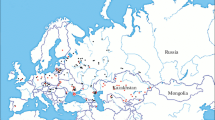Summary
A new large-tailed echinostome cercaria with 22 collar spines and 36 flame cells in all has been experimentally connected with Stephanoprora denticulata. Chickens serve as suitable definitive laboratory hosts wheras Actitis macularia is the natural definitive host. Freshwater fish, Lebistes reticulatus, are the second intermediate hosts. The synonymy of the species has been discussed and there is a proposal for the rejection of the genus Beaverostomum. There is also a key for the separation of the large-tailed echinostome cercariae.
Zusammenfassung
Eine neue breitschwänzige echinostome Cercarie mit 22 Kragenstacheln und insgesamt 36 Wimperflammenzellen stellte sich experimentell als zu Stephanoprora denticulata gehörig heraus. Küken dienen als geeignete Endwirte, während Actitis macularia der natürliche Endwirt ist. Süßwasserfische der Art Lebistes reticulatus sind die 2. Zwischenwirte. Die Synonymie der Art wird diskutiert, und es wird ein Vorschlag für die Verwerfung des Genus Beaverostomum gemacht. Außerdem wird ein Bestimmungsschlüssel für die breitschwänzigen echinostomen Cercarien gegeben.
Similar content being viewed by others
References
Abdel-Malek, E. T.: Cercaria chandleri, a new echinostome species from the snail Helisoma corpulentum, in Lake Itasca, Minnesota. Trans. Amer. micr. Soc. 71, 277–281 (1952).
— Life history of Petasiger chandleri (Trematoda: Echinostomatidae) from the pied-billed grebe, Podilymbus podiceps podiceps, with some comments on other species of Petasiger. J. Parasit. 39, 152–158 (1953).
Beaver, P. C.: Notes on Stephanoprora polycestus (Dietz) from American crow. Trans. Ill. St. Acad. Sci. 29, 247–250 (1936).
— The morphology and life history of Petasiger nitidus Linton (Trematoda: Echinostomatidae). J. Parasit. 25, 269–276 (1939).
Bhalerao, G. D.: The trematodes of Corvus insolens (A Burbese house crow) with a description of four new species. Parasitology 18, 387–398 (1926).
Brown, F. G.: Some freshwater larval trematodes from Cheshire. Parasitology 23, 88–98 (1931).
Byrd, E. E., and R. J. Reiber: Larval flukes from Tennessee. III. Studies on cercariae from Helisoma trivolvis Say, with the description of new species. Report of Reelfoot Lake Biol. Sta. 4, 132–156 (1940).
Cable, R. R.: An illustrated laboratory manual of parasitology. p. 1–165. Minnessota: Minneapolis, U.S.A.: Burgess Publishing Co. 1964.
Cannon, D. G.: Some trematodes of ducks and geese in eastern Canada. Canad. J. Res. 16, 268–280 (1938).
Dietz, E.: Die Echinostomiden der Vögel. Zool. Anz. 34, 180–192 (1909).
— Die Echinostomiden der Vögel. Zool. Jb. 12, 265–512 (1910).
Dozenko, T. K.: Parasitic worms of domestic birds in Premore Land and biology of Cheilospirura hamulosei. Author's dissertation. Trudy Helminth. Lab. 7, 382–383 (1954).
Etges, F. J.: Cercaria reynoldsi n. sp. (Trematoda: Echinostomatidae) from Helisoma anceps (Menke) in Mountain Lake Virginia. Trans. Amer. micr. Soc. 80, 221–226 (1961).
Faust, E. C.: Notes on South African larval trematodes. J. Parasit. 8, 11–21 (1921).
—, and W. A. Hoffmann: Studies in schistosomiasis mansoni in Puerto Rico. III. Biological studies. I. The extramammalian phases of the life cycle. Puerto Rico J. Publ. Hlth and Trop. Med. 10, 1–47 (1934).
Gupta, R.: On Stephanoprora nigerica sp. nov., with a brief review of the genus Stephanoprora Odhner, 1902 (Trematoda: Echinostomatidae). Zool. Anz. 170, 117–139 (1963).
Hedrick, L. R.: Two new large-tailed cercariae (Psilostomidae) from Northern Michigan. J. Parasit. 29, 182–186 (1943).
Isaitschikow, I. M.: Parasitic worms of domestic animals in Crimea [Russian]. Trudy Sibir. Vet. Inst. Omsk. 6, 47–104 (1924).
Johnston, T. H., and L. M. Angel: Life history of the trematode Petasiger australis n. sp. Trans. roy. Soc. S. Aust. 65, 285–291 (1941).
Khan, D.: Studies on larval trematodes infecting freshwater snails in London (U.K.) and some adjoining areas. J. Helminth. 34, 277–304 (1960).
Kuntz, R. E., and A. C. Chandler: Studies on Egyptian trematodes with special reference to the heterophyids of mammals. I. Adult flukes, with descriptions of Phagicola longicollis n. sp., Cynodiplostomum namurii n. sp., and a Stephanoprora from cats. J. Parasit. 42, 445–459 (1956).
Lal, M. B.: Studies in helminthology. Trematode parasites of birds. Proc. Ind. Acad. Soi. 10, 111–200 (1939).
Lee, H. F., and B. S. Seo: A new large-tailed echinostome cercaria from Amnicola limosa (Say) in the Douglas Lake region of Michigan. Trans. Amer. micr. Soc. 78, 215–219 (1959).
Lutz, A.: Estudios de Zoologia y Parasitologia Venezolanas. Rio de Janeiro 1928. 133 pp.
Mendheim, H.: Beiträge zur Systematik und Biologie der Familie Echinostomidae (Trematoda). Nova Acta Leop. Carol. 8, 489–588 (1940).
Miller jr., H. M.: The larval trematode infestation of the freshwater mollusks of San Juan Island, Puget Sound. Wash. Univ. Sc. Ser. 13, 9–22 (1925).
— A new large-tailed echinostome cercaria from North America. Trans. Amer. micr. Soc. 48, 310–313 (1929).
Nasir, P.: Two new species of giant-tailed echinostome cercariae from Planorbis carinatus (Müll). Trans. Amer. micr. Soc. 81, 132–137 (1962).
Odhner, T.: Trematoden aus Reptilien nebst allgemeinen systematischen Bemerkungen. Ofversight Kongl. Vetensk-Akad. Förh. Stockh. 1, 19–45 (1902).
-- Nordafrikanische Trematoden größtenteils vom weißen Nil. Res. Sewd. Zool. Exp. Egypt and White Nile, 1901, No 23 A, 1–170 (1910).
O'Roke, E. C.: Larval trematodes from Kansas freshwater snails. Kans. Univ. Sci. Bull. 10, 161–180 (1917).
Skrjabin, K. I., and E. I. Baschkirova: Trematodes of animals and man 12, 1–932 (1956).
Stunkard, H. W., and J. R. Uzmann: The life cycle of the digenetic trematode Stephanoprora denticulata (Rudolphi, 1802) Odhner, 1910. J. Parasit. 48, 23 (1960).
Sudarikov, B. E.: On the trematode fauna of vertebrates in Middle Volga Provinces. Gelm. Lab. Trudy 3, 131–141 (1950).
Yamaguti, S.: Studies on the helminth fauna of Japan. I. Trematodes of birds, reptiles and mammals. Jap. J. Zool. 5, 1–134 (1933).
— Studies on the helminth fauna of Japan. Part 25. Trematodes of birds IV. Jap. J. Zool. 8, 129–210 (1939).
-- Systema Helminthum. In two parts. New York and London: Interscience Publishers.
Author information
Authors and Affiliations
Rights and permissions
About this article
Cite this article
Nasir, P., Scorza, J.V. Studies on Freshwater Larval Trematodes. Z. F. Parasitenkunde 30, 134–148 (1968). https://doi.org/10.1007/BF00259722
Received:
Issue Date:
DOI: https://doi.org/10.1007/BF00259722




